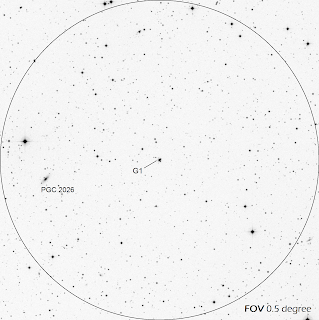OBSERVING REPORT
G1 - GLOBULAR CLUSTER (DWARF GALAXY CORE?) IN ANDROMEDA GALAXY
Date: September 19, 2014
Time: -
Telescope: 20" (50cm) f/3.55
Observer: Leo Cavagnaro
Finder Chart
How to find it,
About 2°40' to the southwest of the core of Messier 31
Stars in map up to visual magnitude 8
Deep-sky objects up to magnitude 13
 OBSERVING REPORT
OBSERVING REPORT
C107 - OPEN CLUSTER IN ANDROMEDA GALAXY
Date: September 19, 2014
Time: -
Telescope: 20" (50cm) f/3.55
How to find it,
About 29' to the southwest of Messier 32.
With a magnitude of 15.1 and a size of 5.7 arc seconds this stellar cluster, situated not very far from the star cloud NGC 206 (about 7 arc minutes due south of this object), is clearly visible through a telescope of this size at 300x. Averted vision helps to get a better view. At this magnification it looks like a very small hazy spot immersed in the nebulous background produced by the Andromeda galaxy.
G1 - GLOBULAR CLUSTER (DWARF GALAXY CORE?) IN ANDROMEDA GALAXY
Date: September 19, 2014
Time: -
Telescope: 20" (50cm) f/3.55
Observer: Leo Cavagnaro
 |
| Click on the image to enlarge |
How to find it,
About 2°40' to the southwest of the core of Messier 31
Stars in map up to visual magnitude 8
Deep-sky objects up to magnitude 13
 |
The 100-inch telescope at Mt. Wilson.
Photo taken by Leo Cavagnaro. |
Andromeda`s was the first extragalactic globular cluster system to be discovered (Hubble 1932). Hubble was able to distinguish Andromeda`s clusters on plates taken with the 100-inch reflector at Mount Wilson Observatory, California, USA. Since Hubble`s identification of 140 cluster candidates many authors have added to the list of cluster candidates.
The first detailed spectroscopic and photometric study of the cluster system was done by van den Bergh (1969) with the Palomar 200-inch Hale Telescope (see paper "Extragalactic Globular Clusters. II. The M31 Globular Cluster System" by John P. Huchra et. al. 1990).
 |
This DSS image gives a clue about how you should see G1in a half a
degree field of view. |
Also
known as Mayall II, it was first
identified as a globular cluster candidate by Mayall
& Eggen (1953) using a
Palomar 48-inch Schmidt plate taken in 1948. It was subsequently named G1
by Sargent et. al. (1977) in their survey with the Kitt Peak 4-m
Mayall telescope of GCs in 29 fields surrounding M31 (see paper "Structural Parameters of
Mayall II = G1 in M31" by
J. Ma et. al. 2007). G1 is the brightest globular cluster
in the Local
Group of galaxies. At a distance of 2.9 million light years it shines at 13.5 visual magnitude.
You must aim the telescope to a zone about 2.5 degrees to the southwest of Messier 31`s core to find it. Through a 20" telescope at 300x the cluster can be identified among two very close stars which form,
with G1, a very small and tight equilateral triangle (look at the pictures). The globular cluster definitively looks non
stellar at this power. Averted vision improves the view of it.
In the paper "Mayall II ≡ G1 in M31: Giant Globular Cluster or Core of a Dwarf Elliptical Galaxy?" (G. Meylan et. al. 2001), the researchers state that this globular cluster, like ω Centauri, has been considered as the possible remaining core of a former dwarf elliptical galaxy which would have lost most of its envelope through tidal interaction with its host galaxy.
In the paper "Mayall II ≡ G1 in M31: Giant Globular Cluster or Core of a Dwarf Elliptical Galaxy?" (G. Meylan et. al. 2001), the researchers state that this globular cluster, like ω Centauri, has been considered as the possible remaining core of a former dwarf elliptical galaxy which would have lost most of its envelope through tidal interaction with its host galaxy.
_________________________
 OBSERVING REPORT
OBSERVING REPORTC107 - OPEN CLUSTER IN ANDROMEDA GALAXY
Date: September 19, 2014
Time: -
Telescope: 20" (50cm) f/3.55
Observer: Leo Cavagnaro
How to find it,
About 29' to the southwest of Messier 32.
 |
| Position of C107 in Andromeda Galaxy (Messier 31). |


